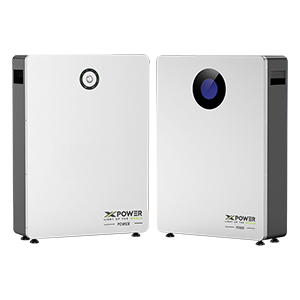Energiespeicherung für Privathaushalte verstehen: Was es ist und wie es funktioniert
Veröffentlichungszeitpunkt: 23.10.2024
Über den Autor:
Willkommen! Es ist mir eine Ehre, Ihnen unsere Marke vorzustellen — Xpower, der Autor dieses freundlichen Leitfadens zu Solarzellentechnologien. Mit über 15 Jahren Erfahrung in der Photovoltaikbranche (PV) bringt Xpower eine Fülle an Wissen und Fachwissen mit.
Xpower ist ein Hersteller und Exporteur im Bereich Solarenergie. Durch jahrelange praktische Erfahrung haben wir die Entwicklung der Solarzellentechnologien und ihre transformativen Auswirkungen auf die Landschaft der erneuerbaren Energien miterlebt.

Da die Welt zunehmend auf erneuerbare Energiequellen umsteigt, hat sich die Energiespeicherung im Eigenheim als wichtige Technologie für Eigenheimbesitzer herausgestellt. In diesem Artikel erfahren Sie, was Energiespeicherung im Eigenheim ist, wie sie funktioniert und welche Vorteile sie bietet.
Was ist Energiespeicherung für Privathaushalte?
Energiespeicherung für Privathaushalte bezieht sich auf Systeme, die Energie für die spätere Verwendung im Haushalt speichern. Diese Systeme verwenden normalerweise Batterien, um Energie aus erneuerbaren Quellen wie Sonnenkollektoren oder Windturbinen zu speichern oder um Energie während der Nebenzeiten zu speichern, wenn die Strompreise niedriger sind. Diese gespeicherte Energie kann dann während der Spitzenzeiten oder bei Stromausfällen verwendet werden, wodurch Hausbesitzer eine bessere Kontrolle über ihren Energieverbrauch haben.

Schlüsselkomponenten von Energiespeichersystemen für Wohngebäude
- Batterien: Die häufigste Komponente von Energiespeichersystemen für Privathaushalte. Lithium-Ionen-Batterien sind aufgrund ihrer Effizienz, Langlebigkeit und sinkenden Kosten weit verbreitet.
- Wechselrichter: Wandelt Gleichstrom (DC) aus den Batterien in Wechselstrom (AC) um, der von Haushaltsgeräten genutzt werden kann.
- Laderegler: Verwaltet den Energiefluss zwischen den Solarmodulen (sofern vorhanden), den Batterien und dem elektrischen System des Hauses und sorgt für optimales Laden und Entladen.
- Energiemanagementsystem: Ein Softwaretool, das den Energieverbrauch überwacht und optimiert und es Hausbesitzern ermöglicht, zu verwalten, wann und wie Energie verwendet oder gespeichert wird.
Wie funktioniert die Energiespeicherung in Privathaushalten?
Die Funktionsweise von Energiespeichersysteme für Privathaushalte kann in mehrere wichtige Schritte unterteilt werden:
- Energieerzeugung: Wenn das Haus mit Solarmodulen ausgestattet ist, erzeugen diese während der Sonnenstunden Strom. Diese Energie kann sofort genutzt oder für die spätere Verwendung gespeichert werden.
- Energiespeicherung: Überschüssige Energie, die von den Solarmodulen erzeugt oder außerhalb der Spitzenzeiten gekauft wird, wird an das Batteriespeichersystem gesendet.
- Energieentladung: In Zeiten hoher Nachfrage oder wenn die Solarmodule nicht genügend Energie erzeugen (z. B. nachts), wird die gespeicherte Energie aus den Batterien freigegeben, um das Haus mit Strom zu versorgen.
- Netzinteraktion: Viele Energiespeichersysteme für Privathaushalte können auch mit dem Stromnetz interagieren. Hausbesitzer können überschüssige gespeicherte Energie bei Spitzenbedarf an das Netz zurückverkaufen und so möglicherweise Geld verdienen oder Gutschriften auf ihren Stromrechnungen erhalten.
Vorteile der Energiespeicherung in Privathaushalten
- Einsparmaßnahmen: Durch die Speicherung von Energie außerhalb der Spitzenzeiten können Hausbesitzer ihre Stromrechnung senken, da sie bei steigenden Preisen weniger teure Energie nutzen können.
- Energieunabhängigkeit: Hausbesitzer können sich stärker auf ihre eigene Energieerzeugung und -speicherung verlassen, was die Abhängigkeit vom Stromnetz verringert und die Widerstandsfähigkeit gegen Ausfälle erhöht.
- Umweltauswirkungen: Indem die Energiespeicherung in Privathaushalten eine stärkere Nutzung erneuerbarer Energien ermöglicht, trägt sie zu einer geringeren Abhängigkeit von fossilen Brennstoffen bei und trägt so zur Eindämmung des Klimawandels bei.
- Lastverschiebung: Durch Energiespeicherung können Hausbesitzer ihren Energieverbrauch auf Zeiten verlagern, in denen er billiger oder reichlicher vorhanden ist, und so ihren Gesamtenergieverbrauch optimieren.
- Notstromversorgung: Bei Stromausfällen bieten Energiespeichersysteme eine zuverlässige Ersatzstromquelle und halten kritische Geräte am Laufen.
Abschluss
Energiespeichersysteme für Privathaushalte stellen für Eigenheimbesitzer einen bedeutenden Fortschritt im Energiemanagement dar. Durch Nutzung der Leistung der Batterietechnologie steigern diese Systeme die Energieeffizienz, fördern die Nutzung erneuerbarer Energien und bieten wirtschaftliche Vorteile. Da sich die Technologie weiterentwickelt und zugänglicher wird, wird die Energiespeicherung für Privathaushalte eine wesentliche Rolle bei der Schaffung einer nachhaltigen Energiezukunft spielen.




